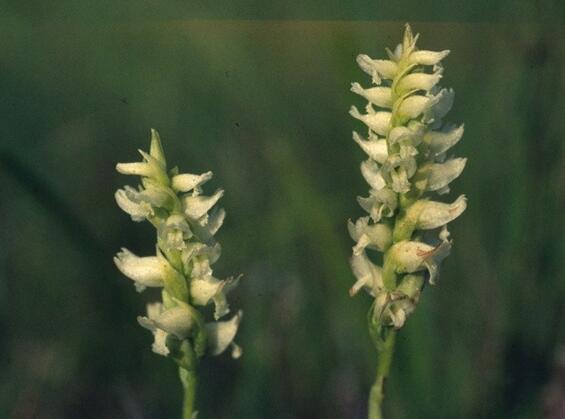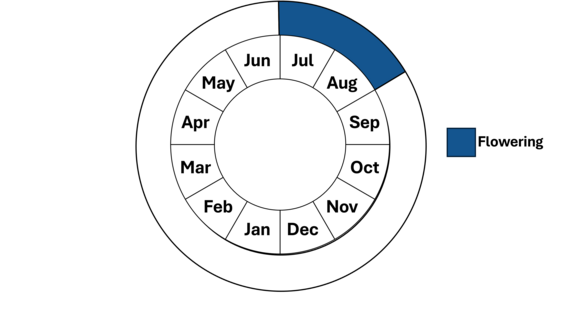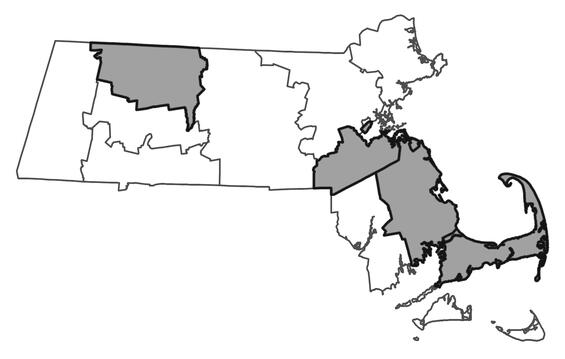- Scientific name: Spiranthes romanzoffiana
- Species of Greatest Conservation Need (MA State Wildlife Action Plan)
- Endangered (MA Endangered Species Act)
Description

Hooded ladies’-tresses is a 1-4 dm (4-16 in) tall perennial herb. This member of the Orchid family (Orchidaceae) has long, narrow leaves growing from the bottom of the plant, and may have small, scale-like leaves on the upper stem. White or cream flowers are ornate and fiddle-shaped and grow in a spike around a thick stem. Hooded ladies’-tresses typically grows in swamps, bogs, and along wet shores.
Hooded ladies’-tresses is a short, compact plant with a stout stem. The leaves are narrow, 10-20 cm (4-8 in) long, and are basal, if present at all. Any leaves on the upper part of the stem are highly reduced and scale-like. The flowers are white or cream-colored, occur in dense racemes, and are organized in three ranks around the stem. The flowering spikes are 4-8 cm (1.5-3 in) long. Sepals and lateral petals are ovate (egg-shaped). One enlarged petal forms a lip, ovate in outline and narrowed towards the middle (fiddle-shaped). Plants flower from July until September, producing a capsular fruit with many small seeds.
Several other species of ladies’-tresses (genus Spiranthes) occur in Massachusetts and across North America and are very similar to hooded ladies’-tresses. Slender ladies’-tresses (S. lacera var. gracilis) and little ladies’-tresses (S. tuberosa) can be distinguished by their egg-shaped leaves, either basal or absent, and grow in fields and open forests. Both have one-sided racemes of white flowers. Slender ladies’-tresses has a floral lip with a green center, bordered by white. Nodding ladies’-tresses (S. cernua) has white horizontal or nodding flowers, arranged in multi-sided racemes. It has long, narrow leaves, and is typically found in moist woods, meadows, and marshes. Grass-leaved ladies’-tresses (S. vernalis) also has long, narrow leaves, but white flowers are present only on one side of a slender, twisting stem. Grass-leaved ladies’-tresses, listed as Threatened in Massachusetts, is found in open fields and meadows.
Life cycle and behavior
This is a perennial species.

Population status
Hooded ladies’-tresses is listed under the Massachusetts Endangered Species Act as Endangered. All listed species are protected from killing, collecting, possessing, or sale, and from activities that would destroy habitat and thus directly or indirectly cause mortality or disrupt critical behaviors. MassWildlife’s Natural Heritage & Endangered Species Program database has 8 records from 4 counties: Berkshire, Franklin, Hampshire, and Essex. Three of those records are within the last 25-year period.
Distribution and abundance
Hooded ladies’-tresses extends across North America, from Labrador and Newfoundland to Alaska, and from New England to Michigan, Colorado and California. Its range continues southward in the United States through Pennsylvania and Louisiana. NatureServe considers the species to be Globally Secure, G5. In New England, hooded ladies’-tresses is historic in Connecticut and rare in Vermont.

Habitat
In Massachusetts, hooded ladies’-tresses typically grows in wet calcareous or circumneutral areas, and in rocky soils with peat. It is found in swamps, bogs, calcareous fens, and meadows, and can occur in damp woodlands, often in the vicinity of small streams and seeps. It is often found with grass-of-parnassus (Parnassia glauca), fen cotton-grass (Eriophorum viridicarinatum), and spike rush (Eleocharis spp.). Other associated species may include shrubby cinquefoil (Dasiphora floribunda), round-leaved sundew (Drosera rotundifolia), and various species of sedge (Carex spp.), rush (Juncus spp.), and sphagnum (Sphagnum spp.).
Healthy habitats are vital for supporting native wildlife and plants. Explore habitats and learn about conservation and restoration in Massachusetts.
Threats
This species is small and sensitive to trampling. Other primary threats include changes to site hydrology and chemistry, overshading, spread of invasive species, and loss of habitat to development.
Conservation
As for many rare species, exact needs for management of hooded ladies’-tresses are not known. The following comments are based primarily on observations of populations in Massachusetts. Hooded ladies-tresses grows in the disturbance-sensitive habitats of circumneutral to alkaline calcareous fens, as well as wet swamps, woods, and meadows. Any disturbance such as a change in water levels or chemistry of the habitat, logging, or development should be minimized, and trail access should be limited near habitat sites to prevent trampling. Hooded ladies’-tresses may also be subject to shading by canopy trees and large shrubs, or competition from invasive, non-native species such as spearmint (Mentha spicata) or glossy buckthorn (Frangula alnus). Removal of the invasive species in such cases may improve the survival and growth of hooded ladies’-tresses. All active management of rare plant populations (including invasive species removal) is subject to review under the Massachusetts Endangered Species Act and should be planned in close consultation with MassWildlife’s Natural Heritage & Endangered Species Program.
References
NatureServe. 2010. NatureServe Explorer: An online encyclopedia of life [web application]. Version 7.1. NatureServe, Arlington, Virginia. Available http://www.natureserve.org/explorer. (Accessed: January 27, 2011 ).
Contact
| Date published: | May 8, 2025 |
|---|